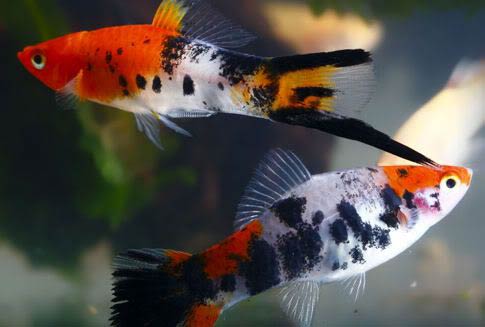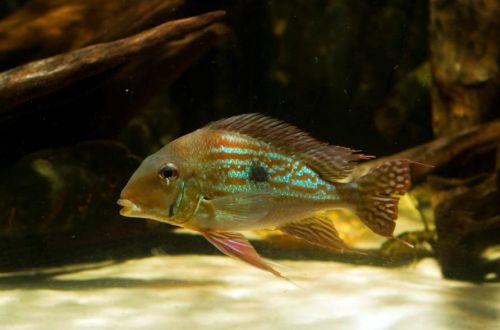
Red-nosed Rasbora
Red-nosed Rasbora or Sawbwa, scientific name Sawbwa resplendens, belongs to the Cyprinidae family. A unique species that is found in the only mountain lake in the east of Burma (Southeast Asia). Due to the high demand in the tropical fish market, in its natural habitat it is on the verge of extinction and is listed in the Red Book. The fish supplied to the retail network live in an artificial environment for only a few generations, and some are completely caught from the lake, therefore they require special conditions for keeping and feeding and cannot be recommended to novice aquarists.

The fish has many names, among which there are very original ones such as “Burmese red-nosed”, “Asian red-nosed”, “Sawba Barbus”. The last name is derived from the term Sawba (Sawbwa, which means “king” in the language of the Shan province of Burma, where the unique lake is located.
Contents
Habitat
The red-nosed Rasbora was discovered by researchers in 1918 in Southeast Asia on the territory of modern Burma in Shan Province. In nature, the fish lives in the only mountain lake Inle and its surrounding swamps at an altitude of more than 900 meters above sea level. The lake is not deep, only 2–3 meters deep, “islands” float on the surface, which are dense weaves of plants that provide shelter and food for these fish.
They gather in small shoals and try to stay near the “islands”, as well as along the coast, where there is flooded vegetation (grass, reeds). During the wet season, the level of the lake rises, and the fish find themselves in the surrounding water bodies. The basis of nutrition are small invertebrates, algae and other zooplankton.
Description
A very small fish, reaching a length of no more than 2,5 cm, has an elegant, slender body. Males have a brightly colored head and tail in orange or red, the body is milky blue. Females, in turn, are monochromatic, without bright colors, the color varies from silver to light olive, the fins are transparent. The Red-nosed Tetra from South America has a similar coloration, but these are completely different species that developed separately on different continents.
Food
Savbwa relatively recently began to be successfully bred in captivity, before that they were mainly caught in the wild, so the fish are still poorly acclimatized to the aquarium and do not always accept dry industrial food, although only they can achieve a balanced diet.
It is recommended to feed live foods (daphnia, cyclops, small bloodworms) in combination with a small amount of high quality dry food (crushed flakes or pellets) that contains herbal supplements.
Maintenance and care
Fish are sensitive to water pollution, so effective filtration and periodic cleaning of the soil are essential. Water is recommended to be renewed once a month, at least half. Two heaters should be used, one main and one backup, so that in the event of a failure of one of them, the water temperature does not change. Rasbora has a narrow temperature range, beyond which it quickly dies.
The design should mimic their natural habitat. Substrate of fine sand, dense thickets of broad-leaved plants arranged in groups to leave room for swimming. Floating plants provide additional cover and dim the light. In the design, wooden objects (snags, branches) should be avoided, they can become sources of tannins intolerable to these fish.
Peaceful species, will never become a source of trouble in the aquarium. It is allowed to use other miniature species as neighbors, but no more. Even calm fish of 4 cm in size can cause stress.
Mandatory keeping in a flock of at least 8 individuals, and the number of males should be significantly less than females, the optimal ratio is 4 females per 1 male, otherwise intraspecific skirmishes may occur.
Sexual differences
Males, unlike females, have a different head color – orange or red, and also differ in large sizes.
Breeding / breeding
For breeding, an additional tank is required, where future parents will be transplanted. A capacity of 10 liters or more is enough, as soil, balls of at least 1 cm in diameter or similar gravel. Dense thickets of small-leaved plants, it is allowed to use artificial ones, since during the spawning period the water temperature will be significantly lowered, not all plants are able to survive this. Of the equipment, a filter, an aerator, a thermometer, a heater will not be needed.
Spawning occurs in February, so at the end of January, the fish should be heavily fed with meat food. The male with the brightest color and several females with a noticeable swollen abdomen are transplanted into a separate tank, in which the temperature is gradually lowered to 2–3 ° C over 15-18 days, the water hardness should not be less than 20 ° dH (medium hardness) . If the room temperature is above 18°C, the water should be cooled in the following way: take a plastic bag and fill it with cold tap water, tie it tightly and lower it into the tank, the temperature will gradually drop. This way you can maintain the desired temperature.
Spawning will begin within two weeks, the female will begin to lay eggs in the thickets of plants, and the male will fertilize them. Fish must be full so as not to eat their caviar. After spawning, the fish return to the general aquarium. To avoid temperature shock, the fish should be placed in a plastic bag filled with water from the tank, tied and placed in a common aquarium to even out the temperature, only after that they can be released.
The fry appear in a day, during the week they feed on the remains of the yolk sac of the eggs, and only then are they able to consume microfeed.
Diseases
Red-nosed Rasbora quickly becomes ill if water quality deteriorates, diseases can be different, more in the section “Diseases of aquarium fish”, but if optimal conditions and good nutrition are provided, there are no health problems.





